Analysis of Contemporary Accounting Issues: BHP Billiton & Woolworths
VerifiedAdded on 2020/03/04
|14
|2875
|168
Report
AI Summary
This report provides a critical analysis of the 2016 annual reports of BHP Billiton and Woolworths, evaluating their compliance with the conceptual framework and relevant Australian Accounting Standards Board (AASB) standards. The analysis focuses on key financial statement components, including Property, Plant, and Equipment (PPE), inventories, asset impairment, and contingent liabilities. The report compares the companies' accounting policies with the expected standards, highlighting any discrepancies. Additionally, it discusses the role of prudence in the conceptual framework, its compatibility with neutrality, and its potential implications for corporate reporting. The report also draws a comparison of disclosures in the annual reports of the two companies. The conclusion summarizes the findings, emphasizing the adherence of both companies to accounting standards and the significance of prudence in ensuring accurate and relevant financial information for stakeholders. The report is a valuable resource for understanding contemporary accounting practices and the application of accounting standards in real-world scenarios.
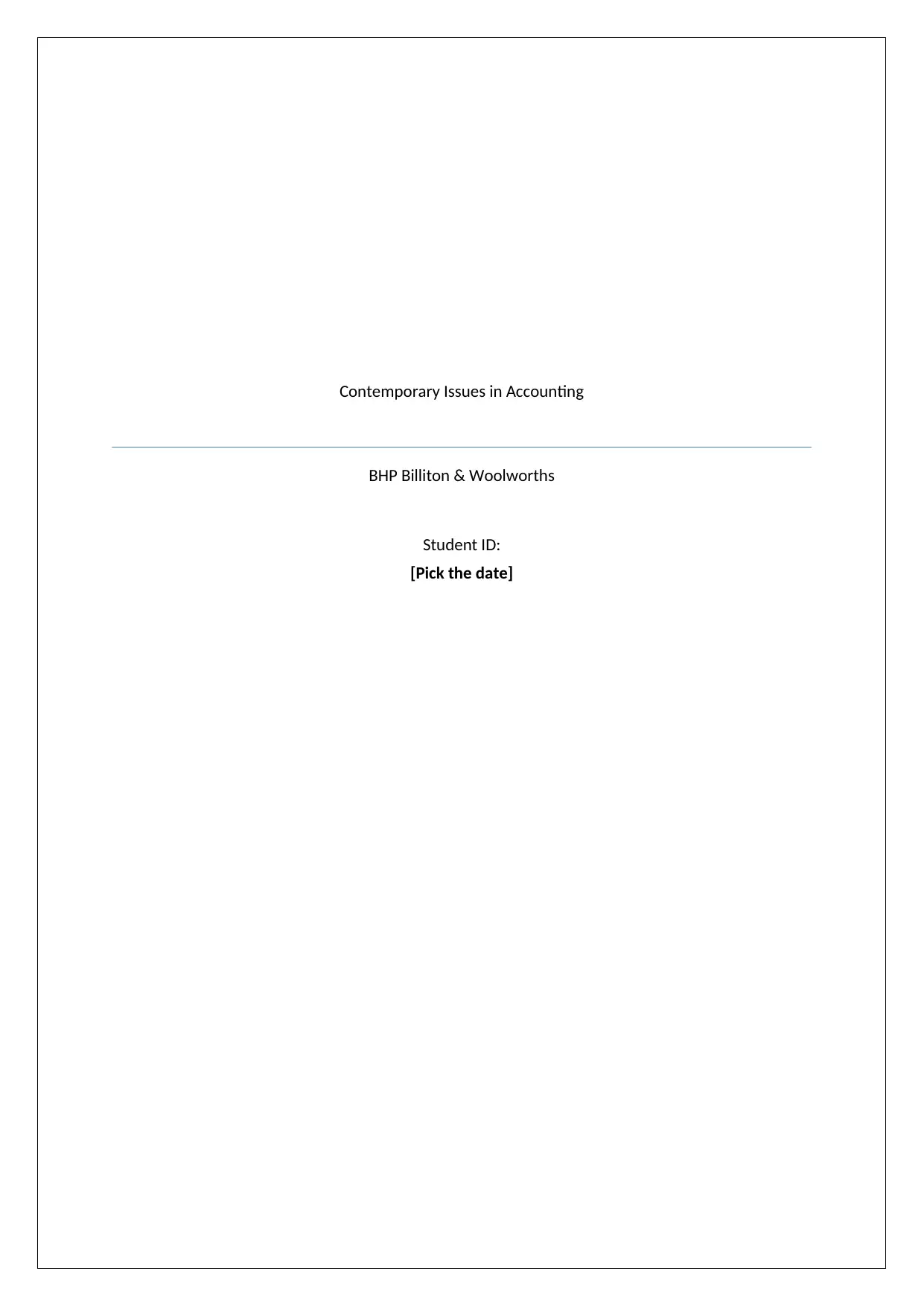
Contemporary Issues in Accounting
BHP Billiton & Woolworths
Student ID:
[Pick the date]
BHP Billiton & Woolworths
Student ID:
[Pick the date]
Paraphrase This Document
Need a fresh take? Get an instant paraphrase of this document with our AI Paraphraser
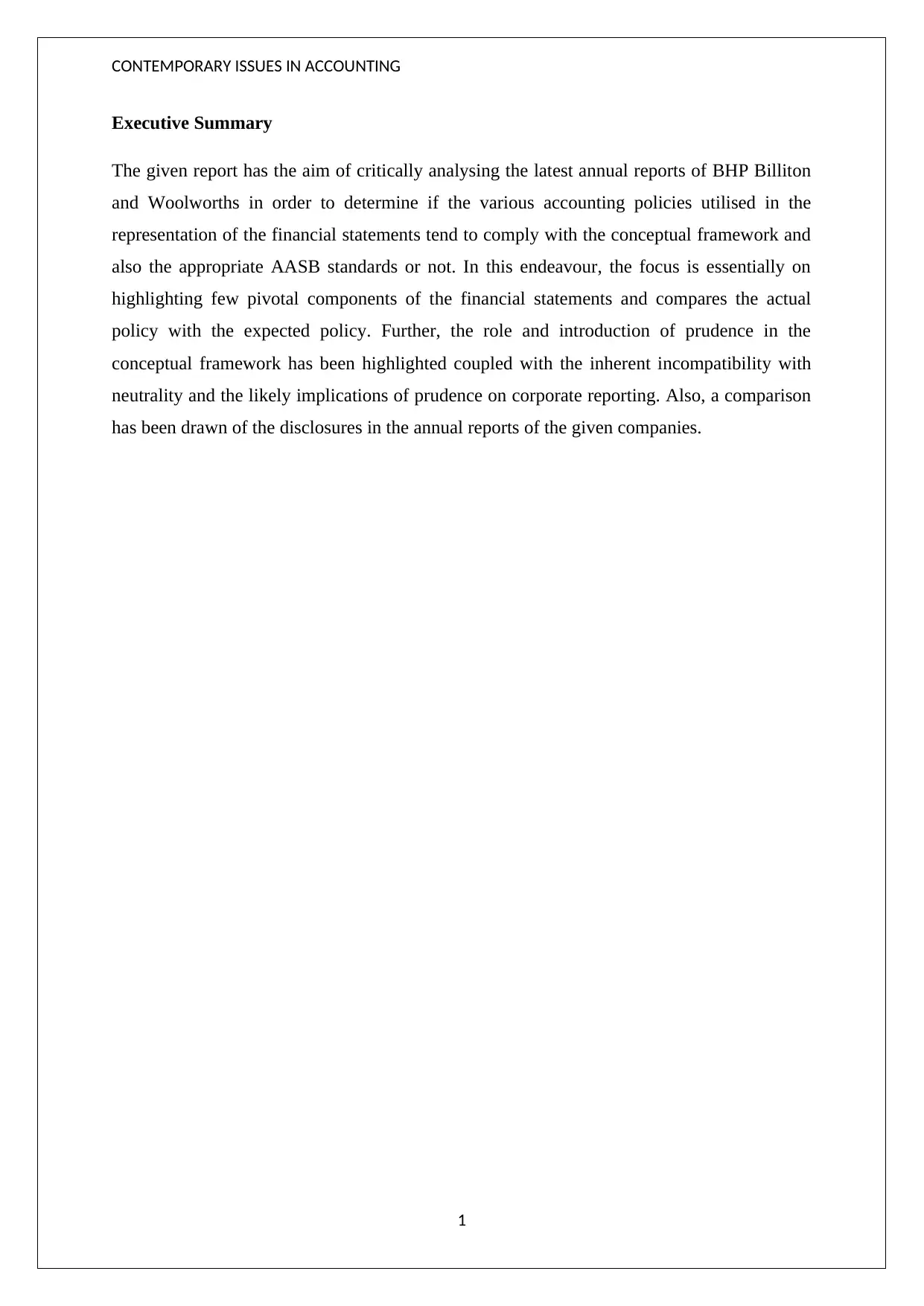
CONTEMPORARY ISSUES IN ACCOUNTING
Executive Summary
The given report has the aim of critically analysing the latest annual reports of BHP Billiton
and Woolworths in order to determine if the various accounting policies utilised in the
representation of the financial statements tend to comply with the conceptual framework and
also the appropriate AASB standards or not. In this endeavour, the focus is essentially on
highlighting few pivotal components of the financial statements and compares the actual
policy with the expected policy. Further, the role and introduction of prudence in the
conceptual framework has been highlighted coupled with the inherent incompatibility with
neutrality and the likely implications of prudence on corporate reporting. Also, a comparison
has been drawn of the disclosures in the annual reports of the given companies.
1
Executive Summary
The given report has the aim of critically analysing the latest annual reports of BHP Billiton
and Woolworths in order to determine if the various accounting policies utilised in the
representation of the financial statements tend to comply with the conceptual framework and
also the appropriate AASB standards or not. In this endeavour, the focus is essentially on
highlighting few pivotal components of the financial statements and compares the actual
policy with the expected policy. Further, the role and introduction of prudence in the
conceptual framework has been highlighted coupled with the inherent incompatibility with
neutrality and the likely implications of prudence on corporate reporting. Also, a comparison
has been drawn of the disclosures in the annual reports of the given companies.
1
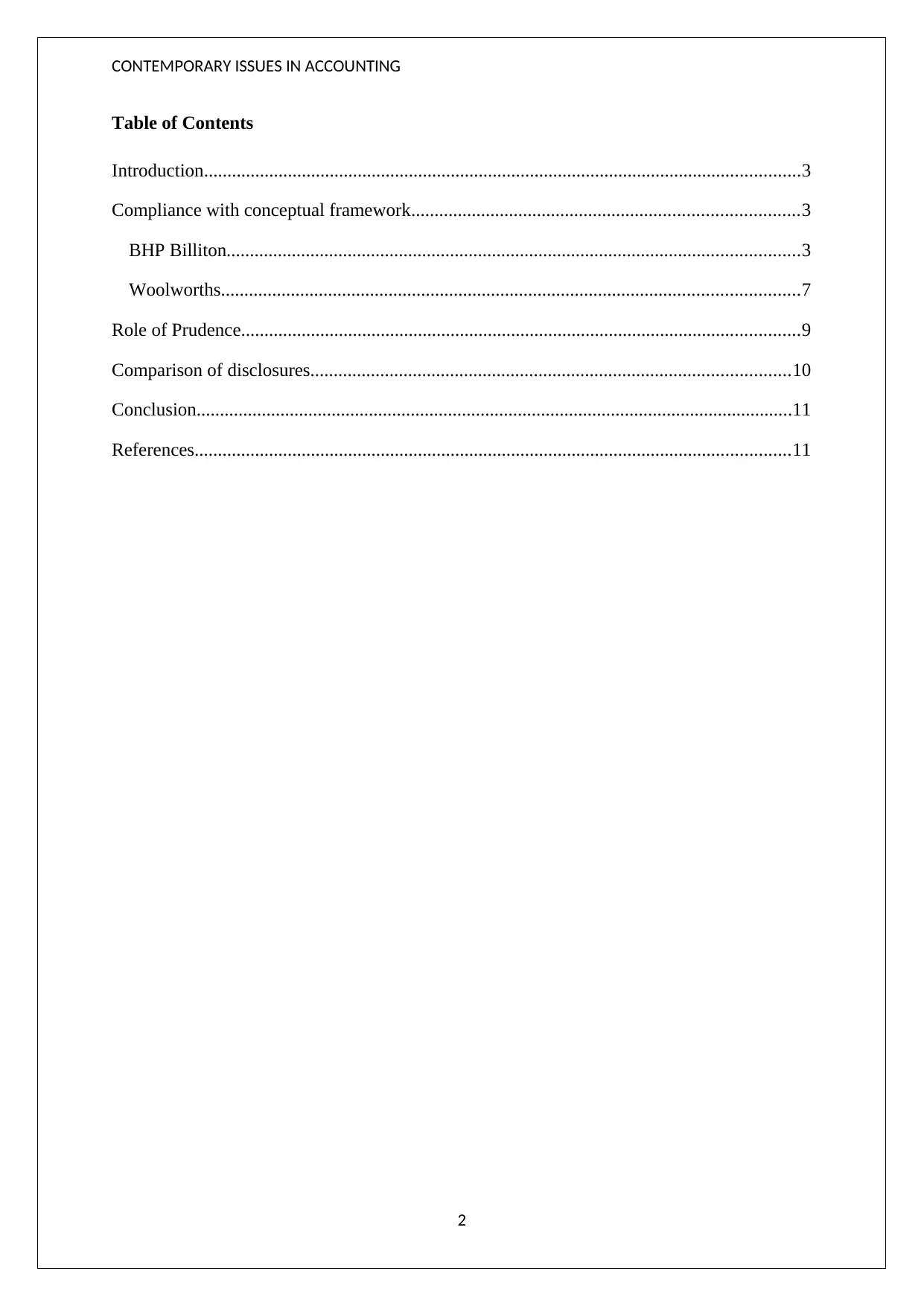
CONTEMPORARY ISSUES IN ACCOUNTING
Table of Contents
Introduction................................................................................................................................3
Compliance with conceptual framework...................................................................................3
BHP Billiton...........................................................................................................................3
Woolworths............................................................................................................................7
Role of Prudence........................................................................................................................9
Comparison of disclosures.......................................................................................................10
Conclusion................................................................................................................................11
References................................................................................................................................11
2
Table of Contents
Introduction................................................................................................................................3
Compliance with conceptual framework...................................................................................3
BHP Billiton...........................................................................................................................3
Woolworths............................................................................................................................7
Role of Prudence........................................................................................................................9
Comparison of disclosures.......................................................................................................10
Conclusion................................................................................................................................11
References................................................................................................................................11
2
⊘ This is a preview!⊘
Do you want full access?
Subscribe today to unlock all pages.

Trusted by 1+ million students worldwide
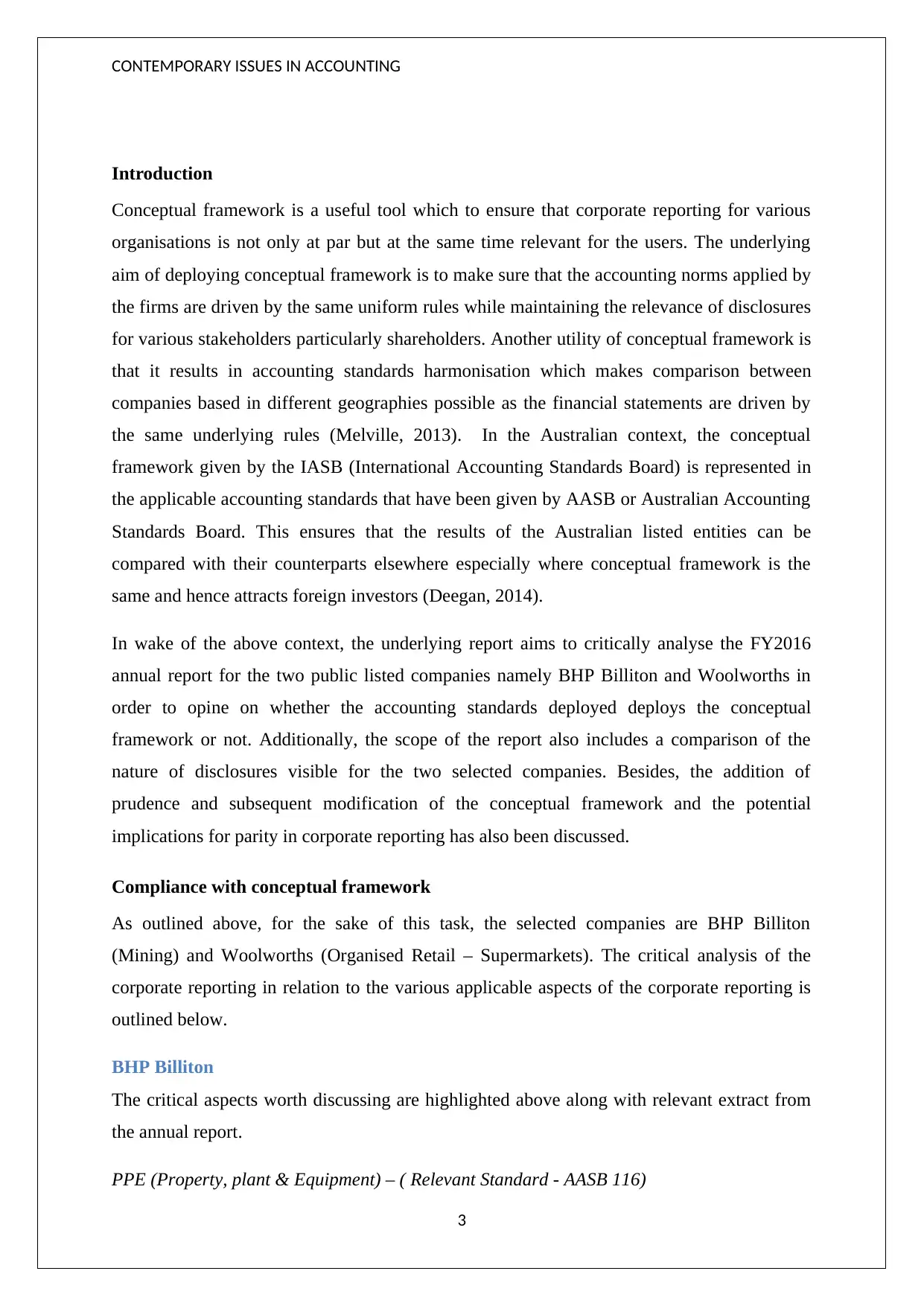
CONTEMPORARY ISSUES IN ACCOUNTING
Introduction
Conceptual framework is a useful tool which to ensure that corporate reporting for various
organisations is not only at par but at the same time relevant for the users. The underlying
aim of deploying conceptual framework is to make sure that the accounting norms applied by
the firms are driven by the same uniform rules while maintaining the relevance of disclosures
for various stakeholders particularly shareholders. Another utility of conceptual framework is
that it results in accounting standards harmonisation which makes comparison between
companies based in different geographies possible as the financial statements are driven by
the same underlying rules (Melville, 2013). In the Australian context, the conceptual
framework given by the IASB (International Accounting Standards Board) is represented in
the applicable accounting standards that have been given by AASB or Australian Accounting
Standards Board. This ensures that the results of the Australian listed entities can be
compared with their counterparts elsewhere especially where conceptual framework is the
same and hence attracts foreign investors (Deegan, 2014).
In wake of the above context, the underlying report aims to critically analyse the FY2016
annual report for the two public listed companies namely BHP Billiton and Woolworths in
order to opine on whether the accounting standards deployed deploys the conceptual
framework or not. Additionally, the scope of the report also includes a comparison of the
nature of disclosures visible for the two selected companies. Besides, the addition of
prudence and subsequent modification of the conceptual framework and the potential
implications for parity in corporate reporting has also been discussed.
Compliance with conceptual framework
As outlined above, for the sake of this task, the selected companies are BHP Billiton
(Mining) and Woolworths (Organised Retail – Supermarkets). The critical analysis of the
corporate reporting in relation to the various applicable aspects of the corporate reporting is
outlined below.
BHP Billiton
The critical aspects worth discussing are highlighted above along with relevant extract from
the annual report.
PPE (Property, plant & Equipment) – ( Relevant Standard - AASB 116)
3
Introduction
Conceptual framework is a useful tool which to ensure that corporate reporting for various
organisations is not only at par but at the same time relevant for the users. The underlying
aim of deploying conceptual framework is to make sure that the accounting norms applied by
the firms are driven by the same uniform rules while maintaining the relevance of disclosures
for various stakeholders particularly shareholders. Another utility of conceptual framework is
that it results in accounting standards harmonisation which makes comparison between
companies based in different geographies possible as the financial statements are driven by
the same underlying rules (Melville, 2013). In the Australian context, the conceptual
framework given by the IASB (International Accounting Standards Board) is represented in
the applicable accounting standards that have been given by AASB or Australian Accounting
Standards Board. This ensures that the results of the Australian listed entities can be
compared with their counterparts elsewhere especially where conceptual framework is the
same and hence attracts foreign investors (Deegan, 2014).
In wake of the above context, the underlying report aims to critically analyse the FY2016
annual report for the two public listed companies namely BHP Billiton and Woolworths in
order to opine on whether the accounting standards deployed deploys the conceptual
framework or not. Additionally, the scope of the report also includes a comparison of the
nature of disclosures visible for the two selected companies. Besides, the addition of
prudence and subsequent modification of the conceptual framework and the potential
implications for parity in corporate reporting has also been discussed.
Compliance with conceptual framework
As outlined above, for the sake of this task, the selected companies are BHP Billiton
(Mining) and Woolworths (Organised Retail – Supermarkets). The critical analysis of the
corporate reporting in relation to the various applicable aspects of the corporate reporting is
outlined below.
BHP Billiton
The critical aspects worth discussing are highlighted above along with relevant extract from
the annual report.
PPE (Property, plant & Equipment) – ( Relevant Standard - AASB 116)
3
Paraphrase This Document
Need a fresh take? Get an instant paraphrase of this document with our AI Paraphraser
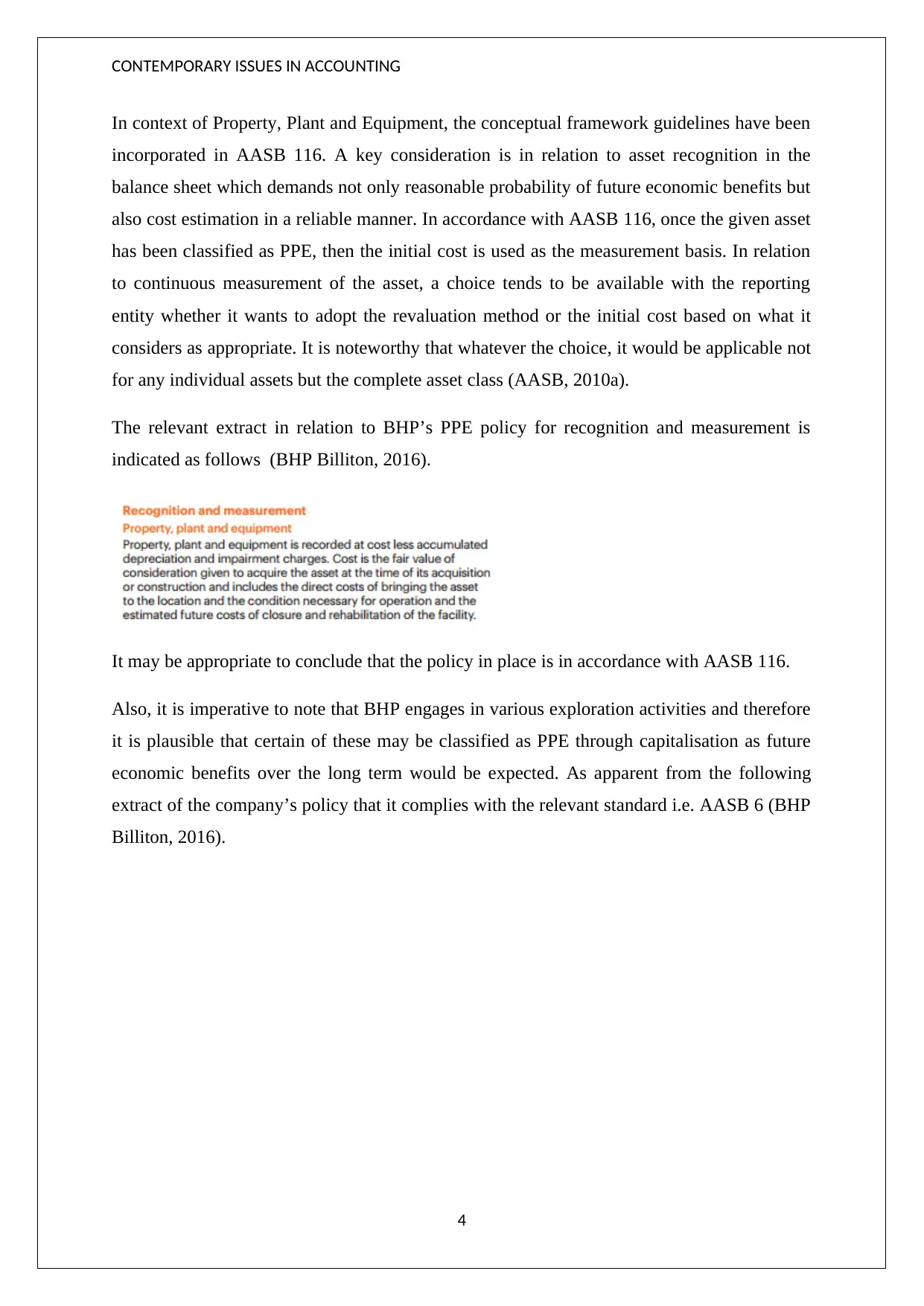
CONTEMPORARY ISSUES IN ACCOUNTING
In context of Property, Plant and Equipment, the conceptual framework guidelines have been
incorporated in AASB 116. A key consideration is in relation to asset recognition in the
balance sheet which demands not only reasonable probability of future economic benefits but
also cost estimation in a reliable manner. In accordance with AASB 116, once the given asset
has been classified as PPE, then the initial cost is used as the measurement basis. In relation
to continuous measurement of the asset, a choice tends to be available with the reporting
entity whether it wants to adopt the revaluation method or the initial cost based on what it
considers as appropriate. It is noteworthy that whatever the choice, it would be applicable not
for any individual assets but the complete asset class (AASB, 2010a).
The relevant extract in relation to BHP’s PPE policy for recognition and measurement is
indicated as follows (BHP Billiton, 2016).
It may be appropriate to conclude that the policy in place is in accordance with AASB 116.
Also, it is imperative to note that BHP engages in various exploration activities and therefore
it is plausible that certain of these may be classified as PPE through capitalisation as future
economic benefits over the long term would be expected. As apparent from the following
extract of the company’s policy that it complies with the relevant standard i.e. AASB 6 (BHP
Billiton, 2016).
4
In context of Property, Plant and Equipment, the conceptual framework guidelines have been
incorporated in AASB 116. A key consideration is in relation to asset recognition in the
balance sheet which demands not only reasonable probability of future economic benefits but
also cost estimation in a reliable manner. In accordance with AASB 116, once the given asset
has been classified as PPE, then the initial cost is used as the measurement basis. In relation
to continuous measurement of the asset, a choice tends to be available with the reporting
entity whether it wants to adopt the revaluation method or the initial cost based on what it
considers as appropriate. It is noteworthy that whatever the choice, it would be applicable not
for any individual assets but the complete asset class (AASB, 2010a).
The relevant extract in relation to BHP’s PPE policy for recognition and measurement is
indicated as follows (BHP Billiton, 2016).
It may be appropriate to conclude that the policy in place is in accordance with AASB 116.
Also, it is imperative to note that BHP engages in various exploration activities and therefore
it is plausible that certain of these may be classified as PPE through capitalisation as future
economic benefits over the long term would be expected. As apparent from the following
extract of the company’s policy that it complies with the relevant standard i.e. AASB 6 (BHP
Billiton, 2016).
4
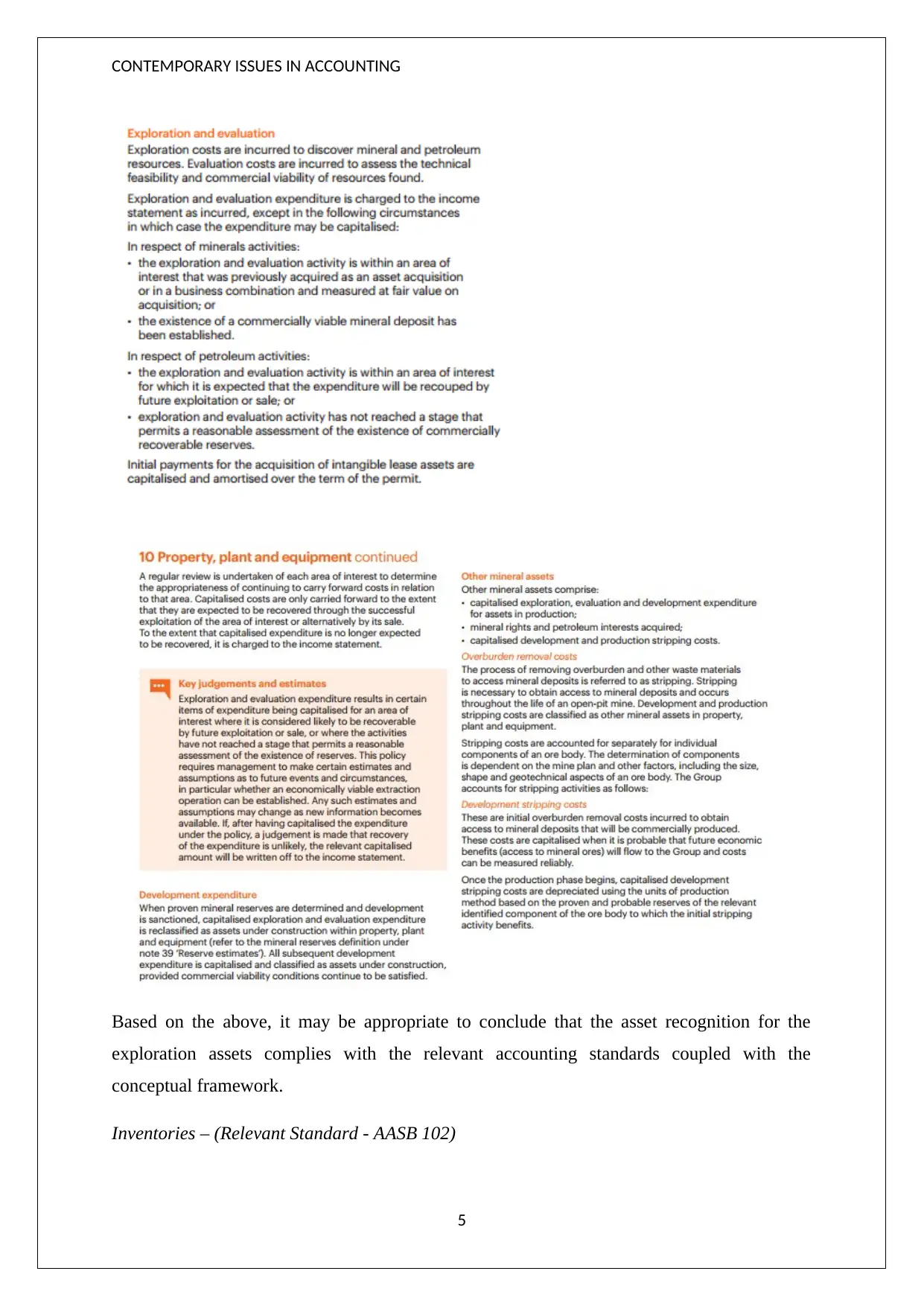
CONTEMPORARY ISSUES IN ACCOUNTING
Based on the above, it may be appropriate to conclude that the asset recognition for the
exploration assets complies with the relevant accounting standards coupled with the
conceptual framework.
Inventories – (Relevant Standard - AASB 102)
5
Based on the above, it may be appropriate to conclude that the asset recognition for the
exploration assets complies with the relevant accounting standards coupled with the
conceptual framework.
Inventories – (Relevant Standard - AASB 102)
5
⊘ This is a preview!⊘
Do you want full access?
Subscribe today to unlock all pages.

Trusted by 1+ million students worldwide
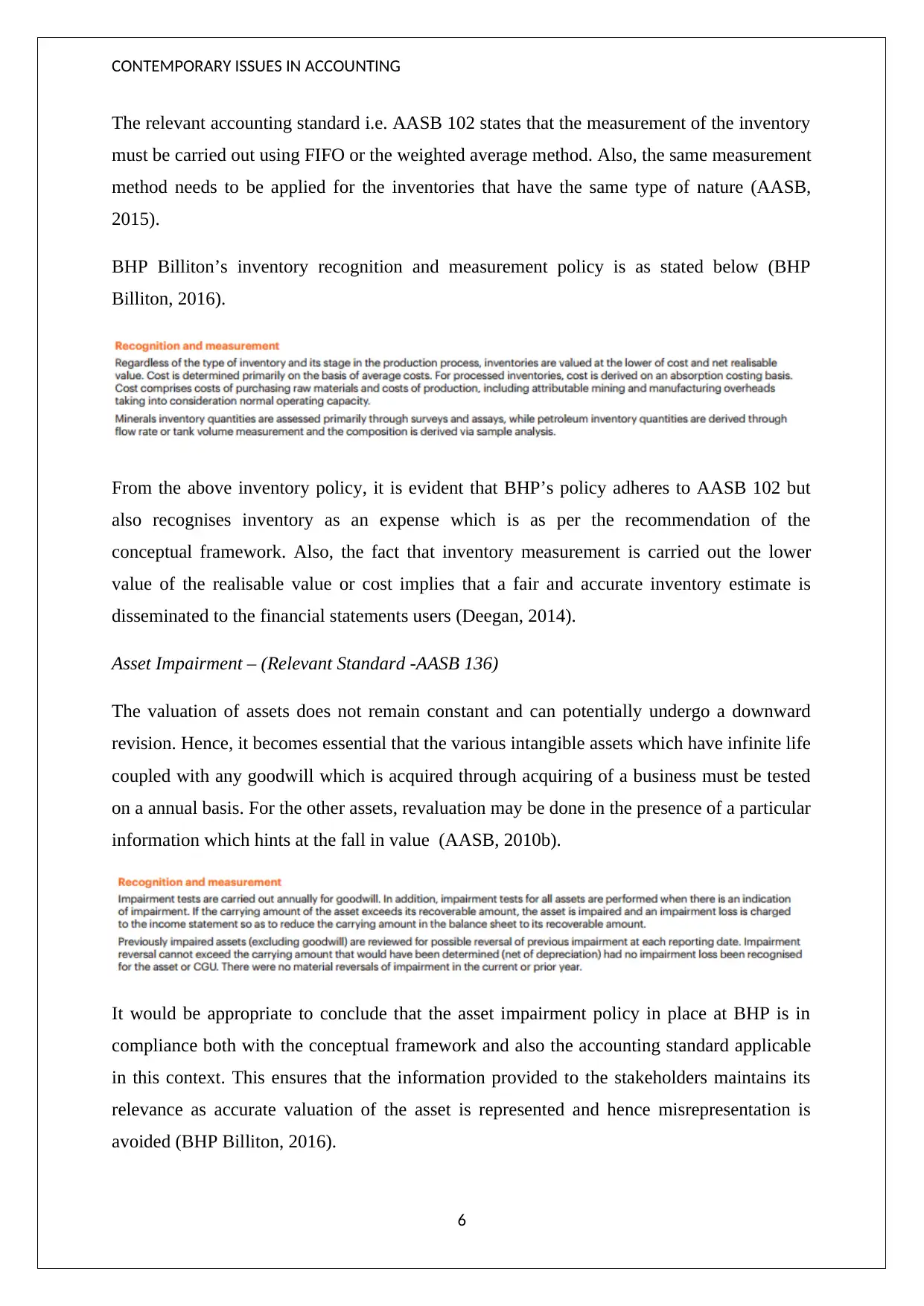
CONTEMPORARY ISSUES IN ACCOUNTING
The relevant accounting standard i.e. AASB 102 states that the measurement of the inventory
must be carried out using FIFO or the weighted average method. Also, the same measurement
method needs to be applied for the inventories that have the same type of nature (AASB,
2015).
BHP Billiton’s inventory recognition and measurement policy is as stated below (BHP
Billiton, 2016).
From the above inventory policy, it is evident that BHP’s policy adheres to AASB 102 but
also recognises inventory as an expense which is as per the recommendation of the
conceptual framework. Also, the fact that inventory measurement is carried out the lower
value of the realisable value or cost implies that a fair and accurate inventory estimate is
disseminated to the financial statements users (Deegan, 2014).
Asset Impairment – (Relevant Standard -AASB 136)
The valuation of assets does not remain constant and can potentially undergo a downward
revision. Hence, it becomes essential that the various intangible assets which have infinite life
coupled with any goodwill which is acquired through acquiring of a business must be tested
on a annual basis. For the other assets, revaluation may be done in the presence of a particular
information which hints at the fall in value (AASB, 2010b).
It would be appropriate to conclude that the asset impairment policy in place at BHP is in
compliance both with the conceptual framework and also the accounting standard applicable
in this context. This ensures that the information provided to the stakeholders maintains its
relevance as accurate valuation of the asset is represented and hence misrepresentation is
avoided (BHP Billiton, 2016).
6
The relevant accounting standard i.e. AASB 102 states that the measurement of the inventory
must be carried out using FIFO or the weighted average method. Also, the same measurement
method needs to be applied for the inventories that have the same type of nature (AASB,
2015).
BHP Billiton’s inventory recognition and measurement policy is as stated below (BHP
Billiton, 2016).
From the above inventory policy, it is evident that BHP’s policy adheres to AASB 102 but
also recognises inventory as an expense which is as per the recommendation of the
conceptual framework. Also, the fact that inventory measurement is carried out the lower
value of the realisable value or cost implies that a fair and accurate inventory estimate is
disseminated to the financial statements users (Deegan, 2014).
Asset Impairment – (Relevant Standard -AASB 136)
The valuation of assets does not remain constant and can potentially undergo a downward
revision. Hence, it becomes essential that the various intangible assets which have infinite life
coupled with any goodwill which is acquired through acquiring of a business must be tested
on a annual basis. For the other assets, revaluation may be done in the presence of a particular
information which hints at the fall in value (AASB, 2010b).
It would be appropriate to conclude that the asset impairment policy in place at BHP is in
compliance both with the conceptual framework and also the accounting standard applicable
in this context. This ensures that the information provided to the stakeholders maintains its
relevance as accurate valuation of the asset is represented and hence misrepresentation is
avoided (BHP Billiton, 2016).
6
Paraphrase This Document
Need a fresh take? Get an instant paraphrase of this document with our AI Paraphraser
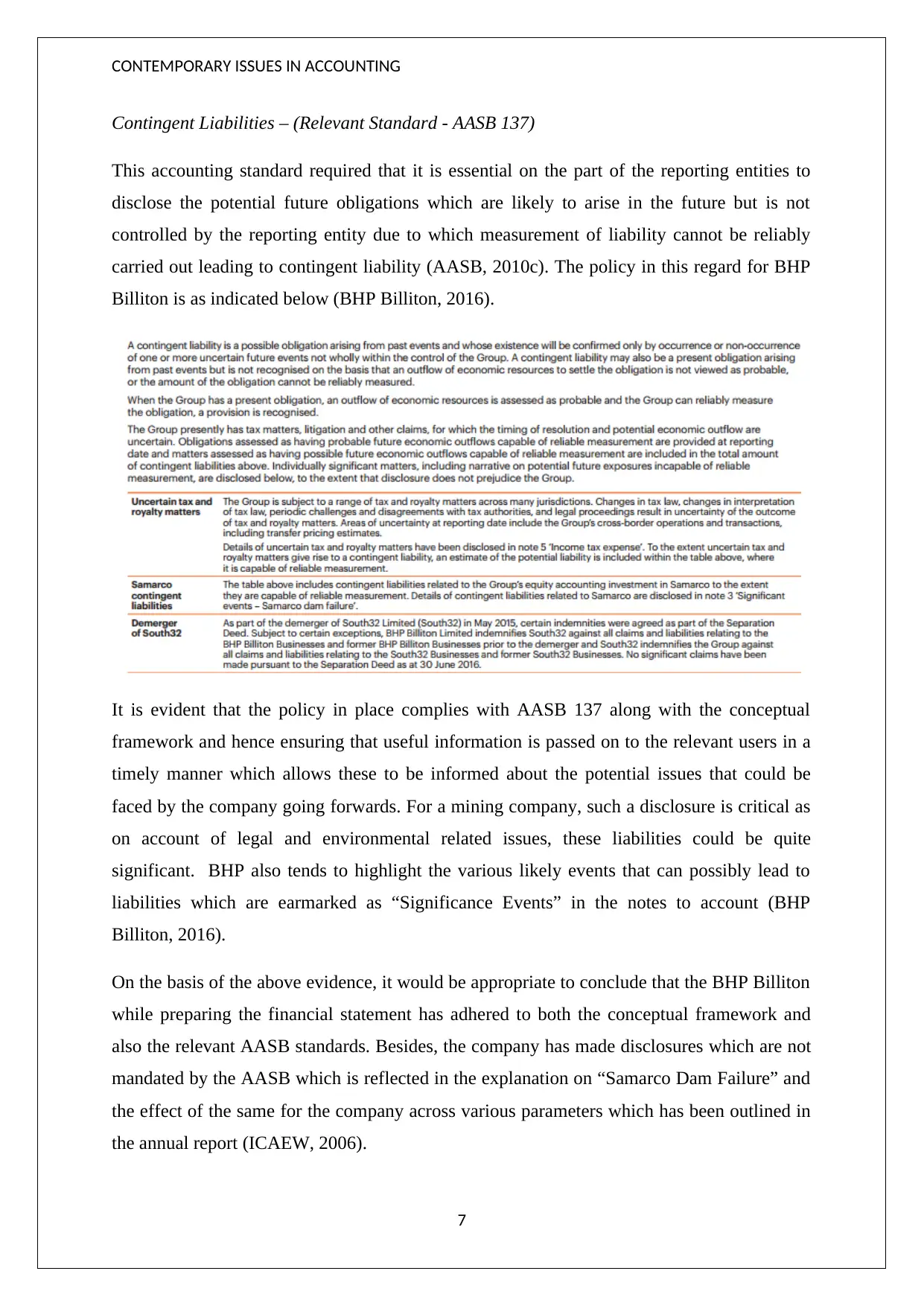
CONTEMPORARY ISSUES IN ACCOUNTING
Contingent Liabilities – (Relevant Standard - AASB 137)
This accounting standard required that it is essential on the part of the reporting entities to
disclose the potential future obligations which are likely to arise in the future but is not
controlled by the reporting entity due to which measurement of liability cannot be reliably
carried out leading to contingent liability (AASB, 2010c). The policy in this regard for BHP
Billiton is as indicated below (BHP Billiton, 2016).
It is evident that the policy in place complies with AASB 137 along with the conceptual
framework and hence ensuring that useful information is passed on to the relevant users in a
timely manner which allows these to be informed about the potential issues that could be
faced by the company going forwards. For a mining company, such a disclosure is critical as
on account of legal and environmental related issues, these liabilities could be quite
significant. BHP also tends to highlight the various likely events that can possibly lead to
liabilities which are earmarked as “Significance Events” in the notes to account (BHP
Billiton, 2016).
On the basis of the above evidence, it would be appropriate to conclude that the BHP Billiton
while preparing the financial statement has adhered to both the conceptual framework and
also the relevant AASB standards. Besides, the company has made disclosures which are not
mandated by the AASB which is reflected in the explanation on “Samarco Dam Failure” and
the effect of the same for the company across various parameters which has been outlined in
the annual report (ICAEW, 2006).
7
Contingent Liabilities – (Relevant Standard - AASB 137)
This accounting standard required that it is essential on the part of the reporting entities to
disclose the potential future obligations which are likely to arise in the future but is not
controlled by the reporting entity due to which measurement of liability cannot be reliably
carried out leading to contingent liability (AASB, 2010c). The policy in this regard for BHP
Billiton is as indicated below (BHP Billiton, 2016).
It is evident that the policy in place complies with AASB 137 along with the conceptual
framework and hence ensuring that useful information is passed on to the relevant users in a
timely manner which allows these to be informed about the potential issues that could be
faced by the company going forwards. For a mining company, such a disclosure is critical as
on account of legal and environmental related issues, these liabilities could be quite
significant. BHP also tends to highlight the various likely events that can possibly lead to
liabilities which are earmarked as “Significance Events” in the notes to account (BHP
Billiton, 2016).
On the basis of the above evidence, it would be appropriate to conclude that the BHP Billiton
while preparing the financial statement has adhered to both the conceptual framework and
also the relevant AASB standards. Besides, the company has made disclosures which are not
mandated by the AASB which is reflected in the explanation on “Samarco Dam Failure” and
the effect of the same for the company across various parameters which has been outlined in
the annual report (ICAEW, 2006).
7
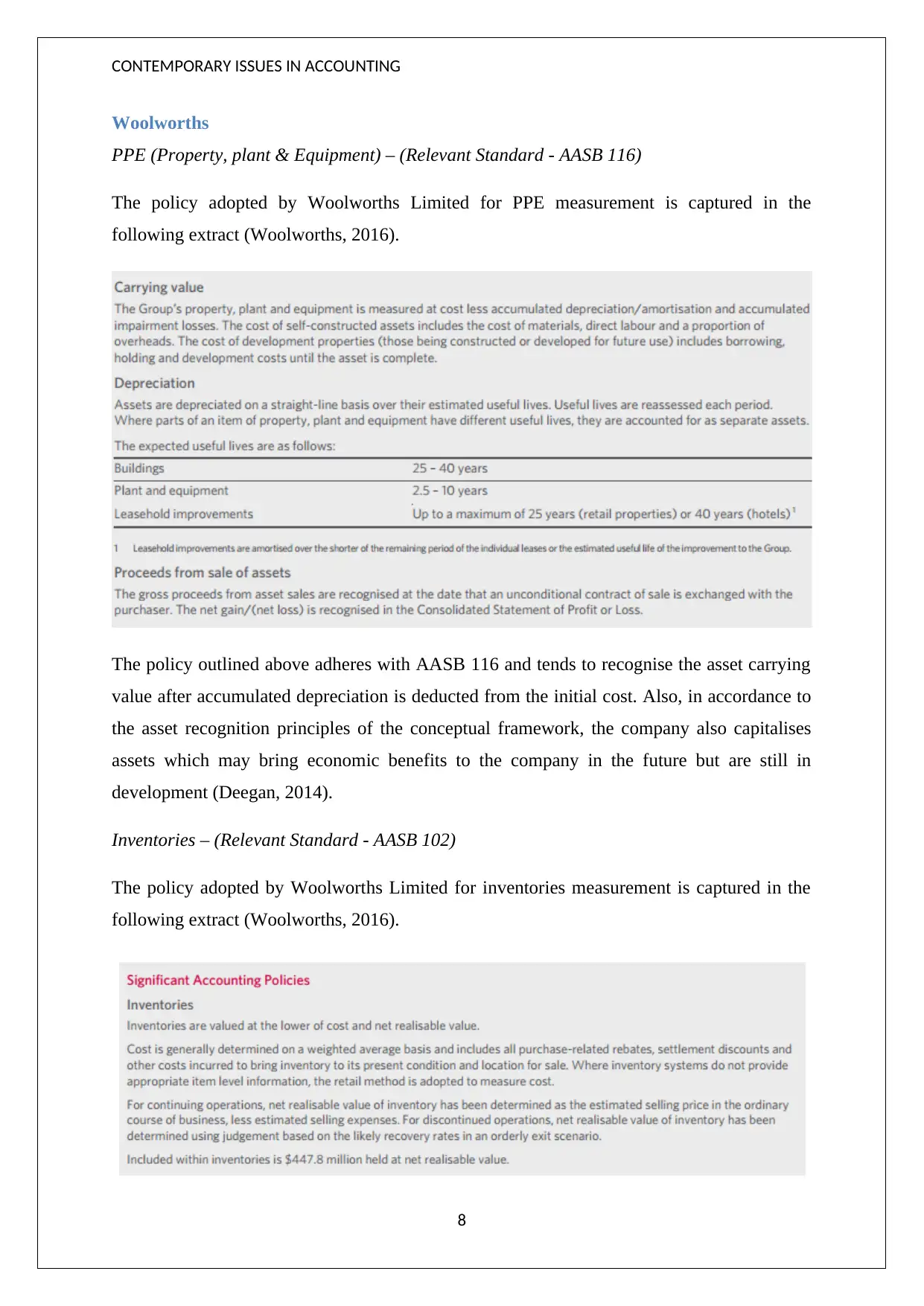
CONTEMPORARY ISSUES IN ACCOUNTING
Woolworths
PPE (Property, plant & Equipment) – (Relevant Standard - AASB 116)
The policy adopted by Woolworths Limited for PPE measurement is captured in the
following extract (Woolworths, 2016).
The policy outlined above adheres with AASB 116 and tends to recognise the asset carrying
value after accumulated depreciation is deducted from the initial cost. Also, in accordance to
the asset recognition principles of the conceptual framework, the company also capitalises
assets which may bring economic benefits to the company in the future but are still in
development (Deegan, 2014).
Inventories – (Relevant Standard - AASB 102)
The policy adopted by Woolworths Limited for inventories measurement is captured in the
following extract (Woolworths, 2016).
8
Woolworths
PPE (Property, plant & Equipment) – (Relevant Standard - AASB 116)
The policy adopted by Woolworths Limited for PPE measurement is captured in the
following extract (Woolworths, 2016).
The policy outlined above adheres with AASB 116 and tends to recognise the asset carrying
value after accumulated depreciation is deducted from the initial cost. Also, in accordance to
the asset recognition principles of the conceptual framework, the company also capitalises
assets which may bring economic benefits to the company in the future but are still in
development (Deegan, 2014).
Inventories – (Relevant Standard - AASB 102)
The policy adopted by Woolworths Limited for inventories measurement is captured in the
following extract (Woolworths, 2016).
8
⊘ This is a preview!⊘
Do you want full access?
Subscribe today to unlock all pages.

Trusted by 1+ million students worldwide
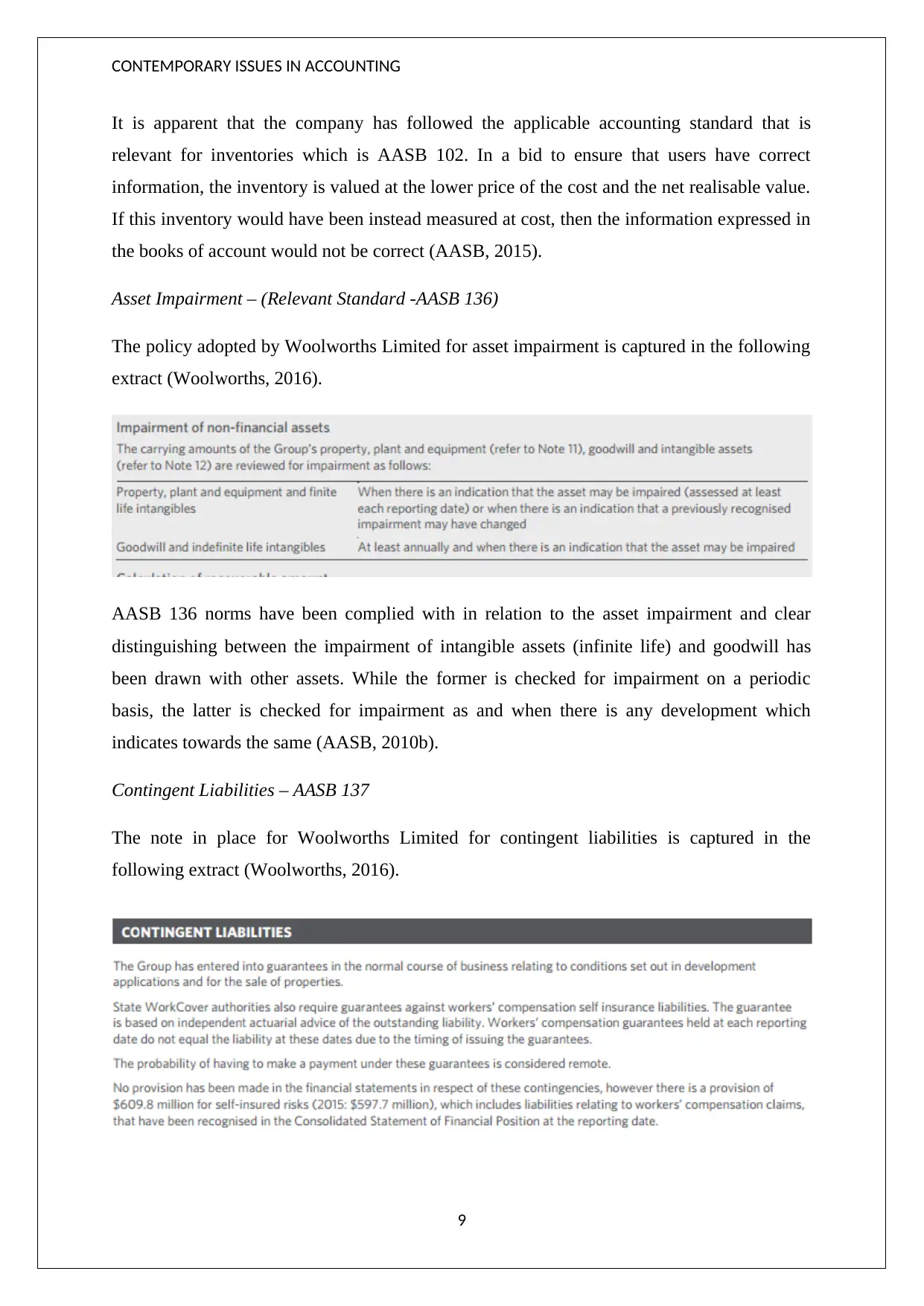
CONTEMPORARY ISSUES IN ACCOUNTING
It is apparent that the company has followed the applicable accounting standard that is
relevant for inventories which is AASB 102. In a bid to ensure that users have correct
information, the inventory is valued at the lower price of the cost and the net realisable value.
If this inventory would have been instead measured at cost, then the information expressed in
the books of account would not be correct (AASB, 2015).
Asset Impairment – (Relevant Standard -AASB 136)
The policy adopted by Woolworths Limited for asset impairment is captured in the following
extract (Woolworths, 2016).
AASB 136 norms have been complied with in relation to the asset impairment and clear
distinguishing between the impairment of intangible assets (infinite life) and goodwill has
been drawn with other assets. While the former is checked for impairment on a periodic
basis, the latter is checked for impairment as and when there is any development which
indicates towards the same (AASB, 2010b).
Contingent Liabilities – AASB 137
The note in place for Woolworths Limited for contingent liabilities is captured in the
following extract (Woolworths, 2016).
9
It is apparent that the company has followed the applicable accounting standard that is
relevant for inventories which is AASB 102. In a bid to ensure that users have correct
information, the inventory is valued at the lower price of the cost and the net realisable value.
If this inventory would have been instead measured at cost, then the information expressed in
the books of account would not be correct (AASB, 2015).
Asset Impairment – (Relevant Standard -AASB 136)
The policy adopted by Woolworths Limited for asset impairment is captured in the following
extract (Woolworths, 2016).
AASB 136 norms have been complied with in relation to the asset impairment and clear
distinguishing between the impairment of intangible assets (infinite life) and goodwill has
been drawn with other assets. While the former is checked for impairment on a periodic
basis, the latter is checked for impairment as and when there is any development which
indicates towards the same (AASB, 2010b).
Contingent Liabilities – AASB 137
The note in place for Woolworths Limited for contingent liabilities is captured in the
following extract (Woolworths, 2016).
9
Paraphrase This Document
Need a fresh take? Get an instant paraphrase of this document with our AI Paraphraser
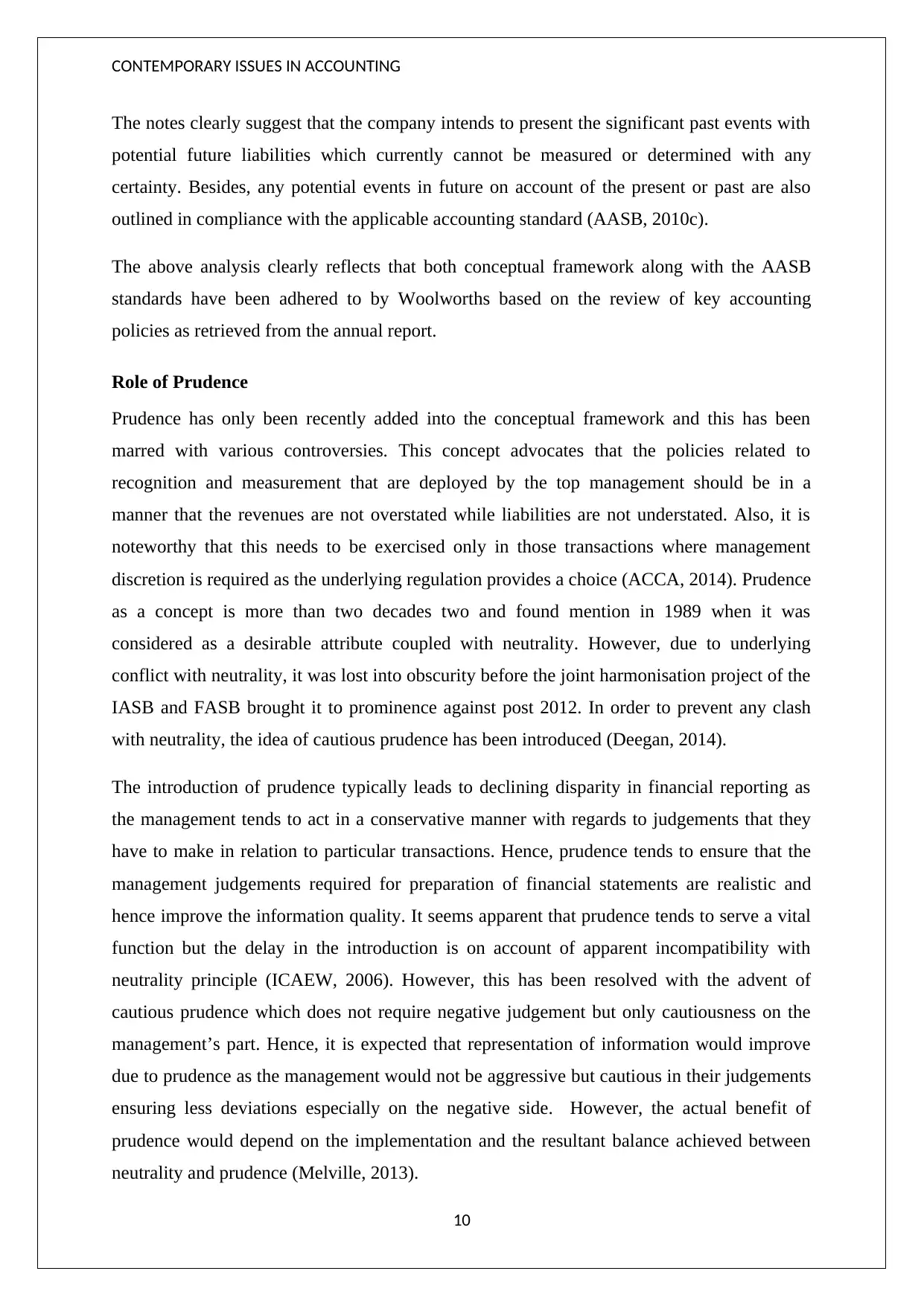
CONTEMPORARY ISSUES IN ACCOUNTING
The notes clearly suggest that the company intends to present the significant past events with
potential future liabilities which currently cannot be measured or determined with any
certainty. Besides, any potential events in future on account of the present or past are also
outlined in compliance with the applicable accounting standard (AASB, 2010c).
The above analysis clearly reflects that both conceptual framework along with the AASB
standards have been adhered to by Woolworths based on the review of key accounting
policies as retrieved from the annual report.
Role of Prudence
Prudence has only been recently added into the conceptual framework and this has been
marred with various controversies. This concept advocates that the policies related to
recognition and measurement that are deployed by the top management should be in a
manner that the revenues are not overstated while liabilities are not understated. Also, it is
noteworthy that this needs to be exercised only in those transactions where management
discretion is required as the underlying regulation provides a choice (ACCA, 2014). Prudence
as a concept is more than two decades two and found mention in 1989 when it was
considered as a desirable attribute coupled with neutrality. However, due to underlying
conflict with neutrality, it was lost into obscurity before the joint harmonisation project of the
IASB and FASB brought it to prominence against post 2012. In order to prevent any clash
with neutrality, the idea of cautious prudence has been introduced (Deegan, 2014).
The introduction of prudence typically leads to declining disparity in financial reporting as
the management tends to act in a conservative manner with regards to judgements that they
have to make in relation to particular transactions. Hence, prudence tends to ensure that the
management judgements required for preparation of financial statements are realistic and
hence improve the information quality. It seems apparent that prudence tends to serve a vital
function but the delay in the introduction is on account of apparent incompatibility with
neutrality principle (ICAEW, 2006). However, this has been resolved with the advent of
cautious prudence which does not require negative judgement but only cautiousness on the
management’s part. Hence, it is expected that representation of information would improve
due to prudence as the management would not be aggressive but cautious in their judgements
ensuring less deviations especially on the negative side. However, the actual benefit of
prudence would depend on the implementation and the resultant balance achieved between
neutrality and prudence (Melville, 2013).
10
The notes clearly suggest that the company intends to present the significant past events with
potential future liabilities which currently cannot be measured or determined with any
certainty. Besides, any potential events in future on account of the present or past are also
outlined in compliance with the applicable accounting standard (AASB, 2010c).
The above analysis clearly reflects that both conceptual framework along with the AASB
standards have been adhered to by Woolworths based on the review of key accounting
policies as retrieved from the annual report.
Role of Prudence
Prudence has only been recently added into the conceptual framework and this has been
marred with various controversies. This concept advocates that the policies related to
recognition and measurement that are deployed by the top management should be in a
manner that the revenues are not overstated while liabilities are not understated. Also, it is
noteworthy that this needs to be exercised only in those transactions where management
discretion is required as the underlying regulation provides a choice (ACCA, 2014). Prudence
as a concept is more than two decades two and found mention in 1989 when it was
considered as a desirable attribute coupled with neutrality. However, due to underlying
conflict with neutrality, it was lost into obscurity before the joint harmonisation project of the
IASB and FASB brought it to prominence against post 2012. In order to prevent any clash
with neutrality, the idea of cautious prudence has been introduced (Deegan, 2014).
The introduction of prudence typically leads to declining disparity in financial reporting as
the management tends to act in a conservative manner with regards to judgements that they
have to make in relation to particular transactions. Hence, prudence tends to ensure that the
management judgements required for preparation of financial statements are realistic and
hence improve the information quality. It seems apparent that prudence tends to serve a vital
function but the delay in the introduction is on account of apparent incompatibility with
neutrality principle (ICAEW, 2006). However, this has been resolved with the advent of
cautious prudence which does not require negative judgement but only cautiousness on the
management’s part. Hence, it is expected that representation of information would improve
due to prudence as the management would not be aggressive but cautious in their judgements
ensuring less deviations especially on the negative side. However, the actual benefit of
prudence would depend on the implementation and the resultant balance achieved between
neutrality and prudence (Melville, 2013).
10
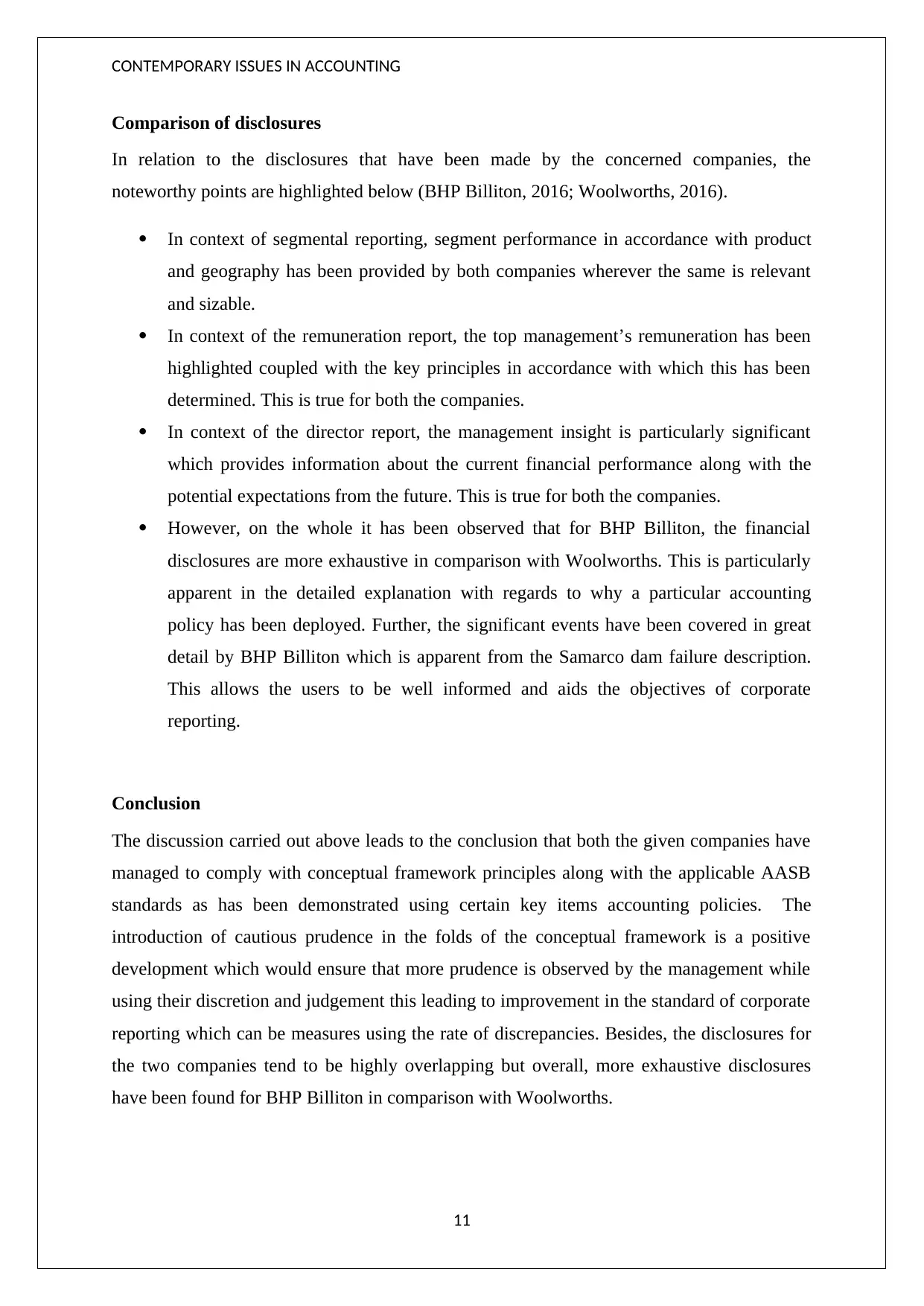
CONTEMPORARY ISSUES IN ACCOUNTING
Comparison of disclosures
In relation to the disclosures that have been made by the concerned companies, the
noteworthy points are highlighted below (BHP Billiton, 2016; Woolworths, 2016).
In context of segmental reporting, segment performance in accordance with product
and geography has been provided by both companies wherever the same is relevant
and sizable.
In context of the remuneration report, the top management’s remuneration has been
highlighted coupled with the key principles in accordance with which this has been
determined. This is true for both the companies.
In context of the director report, the management insight is particularly significant
which provides information about the current financial performance along with the
potential expectations from the future. This is true for both the companies.
However, on the whole it has been observed that for BHP Billiton, the financial
disclosures are more exhaustive in comparison with Woolworths. This is particularly
apparent in the detailed explanation with regards to why a particular accounting
policy has been deployed. Further, the significant events have been covered in great
detail by BHP Billiton which is apparent from the Samarco dam failure description.
This allows the users to be well informed and aids the objectives of corporate
reporting.
Conclusion
The discussion carried out above leads to the conclusion that both the given companies have
managed to comply with conceptual framework principles along with the applicable AASB
standards as has been demonstrated using certain key items accounting policies. The
introduction of cautious prudence in the folds of the conceptual framework is a positive
development which would ensure that more prudence is observed by the management while
using their discretion and judgement this leading to improvement in the standard of corporate
reporting which can be measures using the rate of discrepancies. Besides, the disclosures for
the two companies tend to be highly overlapping but overall, more exhaustive disclosures
have been found for BHP Billiton in comparison with Woolworths.
11
Comparison of disclosures
In relation to the disclosures that have been made by the concerned companies, the
noteworthy points are highlighted below (BHP Billiton, 2016; Woolworths, 2016).
In context of segmental reporting, segment performance in accordance with product
and geography has been provided by both companies wherever the same is relevant
and sizable.
In context of the remuneration report, the top management’s remuneration has been
highlighted coupled with the key principles in accordance with which this has been
determined. This is true for both the companies.
In context of the director report, the management insight is particularly significant
which provides information about the current financial performance along with the
potential expectations from the future. This is true for both the companies.
However, on the whole it has been observed that for BHP Billiton, the financial
disclosures are more exhaustive in comparison with Woolworths. This is particularly
apparent in the detailed explanation with regards to why a particular accounting
policy has been deployed. Further, the significant events have been covered in great
detail by BHP Billiton which is apparent from the Samarco dam failure description.
This allows the users to be well informed and aids the objectives of corporate
reporting.
Conclusion
The discussion carried out above leads to the conclusion that both the given companies have
managed to comply with conceptual framework principles along with the applicable AASB
standards as has been demonstrated using certain key items accounting policies. The
introduction of cautious prudence in the folds of the conceptual framework is a positive
development which would ensure that more prudence is observed by the management while
using their discretion and judgement this leading to improvement in the standard of corporate
reporting which can be measures using the rate of discrepancies. Besides, the disclosures for
the two companies tend to be highly overlapping but overall, more exhaustive disclosures
have been found for BHP Billiton in comparison with Woolworths.
11
⊘ This is a preview!⊘
Do you want full access?
Subscribe today to unlock all pages.

Trusted by 1+ million students worldwide
1 out of 14
Related Documents
Your All-in-One AI-Powered Toolkit for Academic Success.
+13062052269
info@desklib.com
Available 24*7 on WhatsApp / Email
![[object Object]](/_next/static/media/star-bottom.7253800d.svg)
Unlock your academic potential
Copyright © 2020–2025 A2Z Services. All Rights Reserved. Developed and managed by ZUCOL.

![Report: Contemporary Issues in Accounting - [University Name]](/_next/image/?url=https%3A%2F%2Fdesklib.com%2Fmedia%2Fimages%2Fzz%2F9509ff46c136422d929242036a52e1cb.jpg&w=256&q=75)



